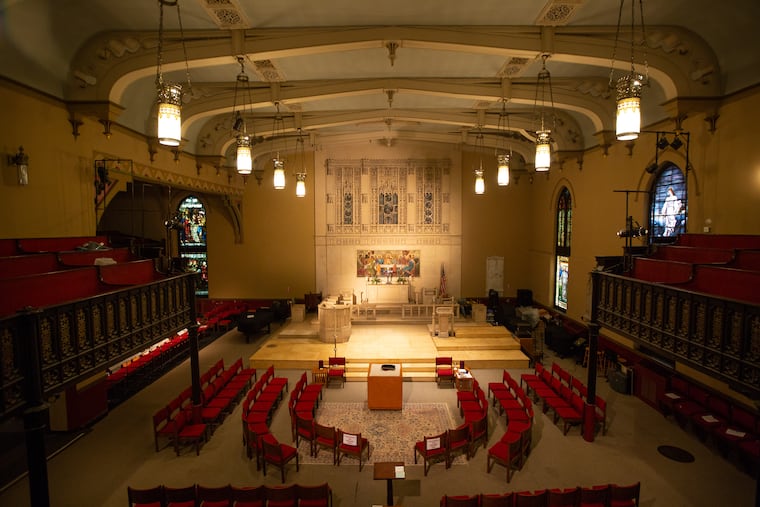Closed Episcopal Church in Center City reopened to find a new mission — and graves beneath the floorboards
A memorial showcasing nine uncovered crypts, some dating to the early 1800s, is part of a resurrected St. Stephen’s, retooled for a new definition of “church.”

For years, St. Stephen’s Episcopal Church in Center City had been inching toward oblivion. The families that sustained it for nearly two centuries were vanishing, until Sunday services became lonesome gatherings of fewer than 10 worshipers.
So, in 2016, leaders of the denomination’s Pennsylvania Diocese decided to close the church at 10th and Ludlow Streets, between Market and Chestnut, even though they would be leaving some longtime parishioners behind — buried beneath the floorboards.
The nine graves, some dating to the early 1800s, are still in the sanctuary, but invisible no more as part of a resurrected St. Stephen’s, retooled for a new definition of “church.”
The change agent was Bishop Daniel Gutierrez, who arrived here from the Episcopal Diocese of the Rio Grande. “When we abandon one of these places," he said, "we abandon the possibilities of spreading what we believe in so deeply.”
Gutierrez, 54, ordered the doors of St. Stephen’s to be reopened in 2017. In the face of trends that have swallowed countless churches — from shrinking funds to the steady growth of “nones” uninterested in any religious affiliation — the move amounted to “taking a step of faith that something would happen,” the bishop said, and “it has.”
The 19th-century American Gothic Revival architecture and Tiffany windows may be the same, but Sunday services are no more. Now closed on the Christian Sabbath, St. Stephen’s instead serves as a four-day-a-week resource center for the community, offering midweek meditation liturgies, performing arts space, and social service referrals to people who are homeless, some of whom spend hours there playing cards, reading, and even napping.
“We can serve a multitude of different purposes that are useful to the neighborhood," and they “have nothing to do with Sunday,” said the Rev. Peter Kountz, the pastor appointed to lead the reimagined church, which will also become a satellite office for the diocese when it moves its headquarters later this year from University City to St. John’s Episcopal Church in Norristown.
But for those simply seeking a space for quiet reflection on the nature of life ever after, there are the graves to contemplate, viewable since March through panels of architectural glass set into the church floor.
Occupying the most elaborate crypt, in the shape of a cross, is William Cragg, the congregation’s first sexton. Nearby lie relatives of the Venerable Cornelia Connelly, a Philadelphia wife and mother who became a Catholic nun and, in 1846, founded the Society for the Holy Child Jesus religious community; she is currently the subject of a cause for sainthood. Among their neighbors are the less-than-divine politician, diplomat, and slave owner James Brown, and Hosea Johns Levis, a banker who, embroiled in an elaborate 1839 fraud case, briefly fled to France before returning to testify for the prosecution.
Their presence in the newly inaugurated Furness Burial Cloister is a throwback to the glory days of institutional religion in Philadelphia.
The sanctuary, consecrated in 1823, was designed by renowned Philadelphia architect William Strickland, with later additions by colleagues Frank Furness and Richard Upjohn.
The first families at St. Stephen’s included businessmen and civic leaders, professors from the then-nearby University of Pennsylvania, and doctors from Thomas Jefferson University Hospital, said Suzanne Glover Lindsay, an art historian and St. Stephen’s archivist and curator.
Within a year of the church’s founding, the congregation purchased property next door, a narrow strip on the north side that became its cemetery in 1825. St. Stephen’s parishioners were buried in vaults with body-length, inscribed stone coverings.
But in 1831, the growing congregation needed more space, a precious commodity in the bustling city. So, the decision was made to build on top of the dearly departed. Over the course of 37 years, the sanctuary was expanded and a small chapel and a three-story administration building constructed.
“They made a choice to live with the dead," Lindsay said, "but to add activities for the living community on top of [them].“
Builders structured the administration addition so that some stone vault covers served as the floor on which parishioners and visitors walked. But in the sanctuary, most of the graves were covered with wood flooring and pews.
More than a century later in 2017, Lindsay, newly retained as the church historian, came upon a hand-drawn map in the St. Stephen’s archives. It showed nine vaults beneath the floor of the 1878 Furness-designed expansion of the sanctuary. She also found photos of the vaults that appeared to have been taken in 1989, when the floor had to be repaired and pews were removed and replaced with chairs.
Kountz and his staff decided to pull up the wood and expose the vaults. To properly bring St. Stephen’s ancestors into the light, they called in a cadre of professionals, including archaeologist Doug Mooney, historic preservationist Suzanna Barucco, structural engineer Jonathan Price, and lighting designer James Crowell.
Creating the burial cloister was, Kountz said, "a matter of honor and respect.”
Still, the early generations should not be faulted for building on top of their dead, according to Lindsay.
“Their choice was to cover the cemetery, leave it intact on sacred ground, and continue with the work of the church,” she said. “That’s a big deal.”